Technology for Independent Living: Benefits & Barriers in H&S
VerifiedAdded on 2024/06/11
|20
|4082
|295
Report
AI Summary
This report provides a comprehensive overview of how technology supports independent living for individuals with disabilities, focusing on the benefits of assistive technology in health and social care (H&S) settings. It examines the influence of recent technological advancements, highlighting how devices and systems aid individuals in performing daily tasks, improving communication, and enhancing overall quality of life. The report also addresses potential barriers and limitations to the use of supportive technologies, including device selection, learning restrictions, economic constraints, and psychological resistance. Furthermore, it delves into the safety aspects and ethical issues associated with assistive technology, emphasizing the importance of proper maintenance, trained professionals, and informed consent. The analysis incorporates a case study approach, illustrating the practical application and impact of assistive technology on individuals' lives, while also considering the benefits for H&S organizations in terms of improved planning, risk management, and operational efficiency. This document is available on Desklib, where students can find a wealth of past papers and solved assignments.
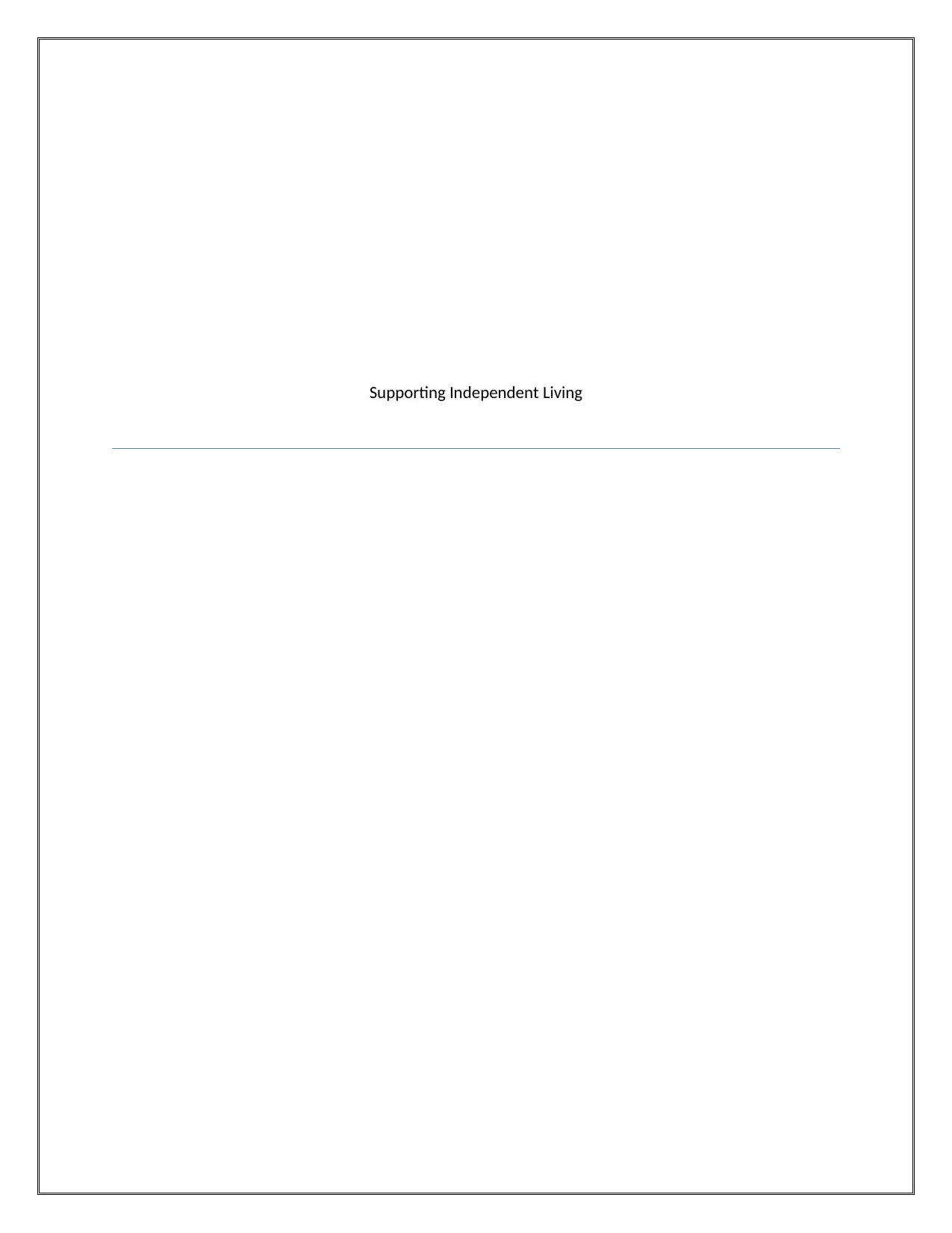
Supporting Independent Living
Paraphrase This Document
Need a fresh take? Get an instant paraphrase of this document with our AI Paraphraser
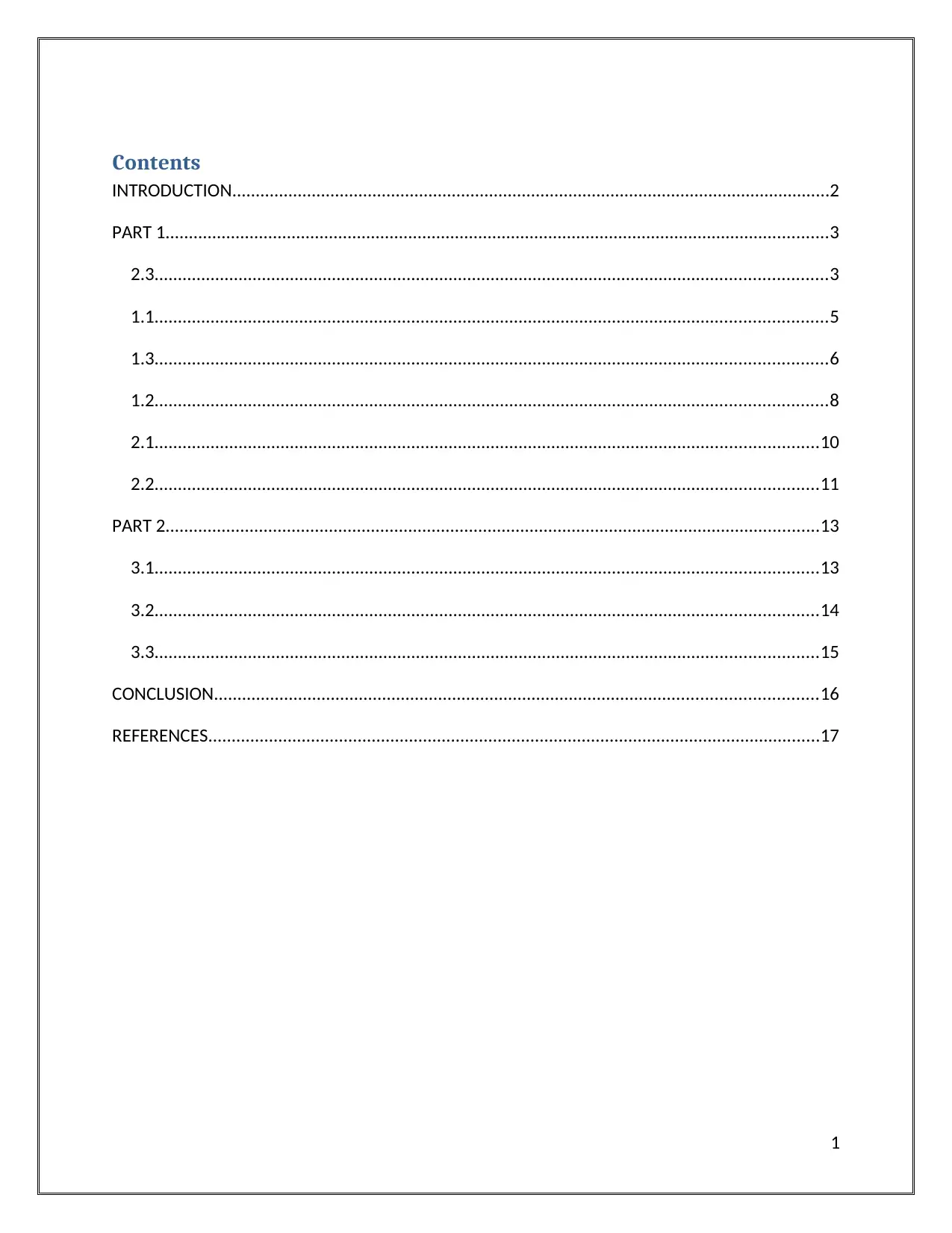
Contents
INTRODUCTION................................................................................................................................2
PART 1..............................................................................................................................................3
2.3................................................................................................................................................3
1.1................................................................................................................................................5
1.3................................................................................................................................................6
1.2................................................................................................................................................8
2.1..............................................................................................................................................10
2.2..............................................................................................................................................11
PART 2............................................................................................................................................13
3.1..............................................................................................................................................13
3.2..............................................................................................................................................14
3.3..............................................................................................................................................15
CONCLUSION.................................................................................................................................16
REFERENCES...................................................................................................................................17
1
INTRODUCTION................................................................................................................................2
PART 1..............................................................................................................................................3
2.3................................................................................................................................................3
1.1................................................................................................................................................5
1.3................................................................................................................................................6
1.2................................................................................................................................................8
2.1..............................................................................................................................................10
2.2..............................................................................................................................................11
PART 2............................................................................................................................................13
3.1..............................................................................................................................................13
3.2..............................................................................................................................................14
3.3..............................................................................................................................................15
CONCLUSION.................................................................................................................................16
REFERENCES...................................................................................................................................17
1
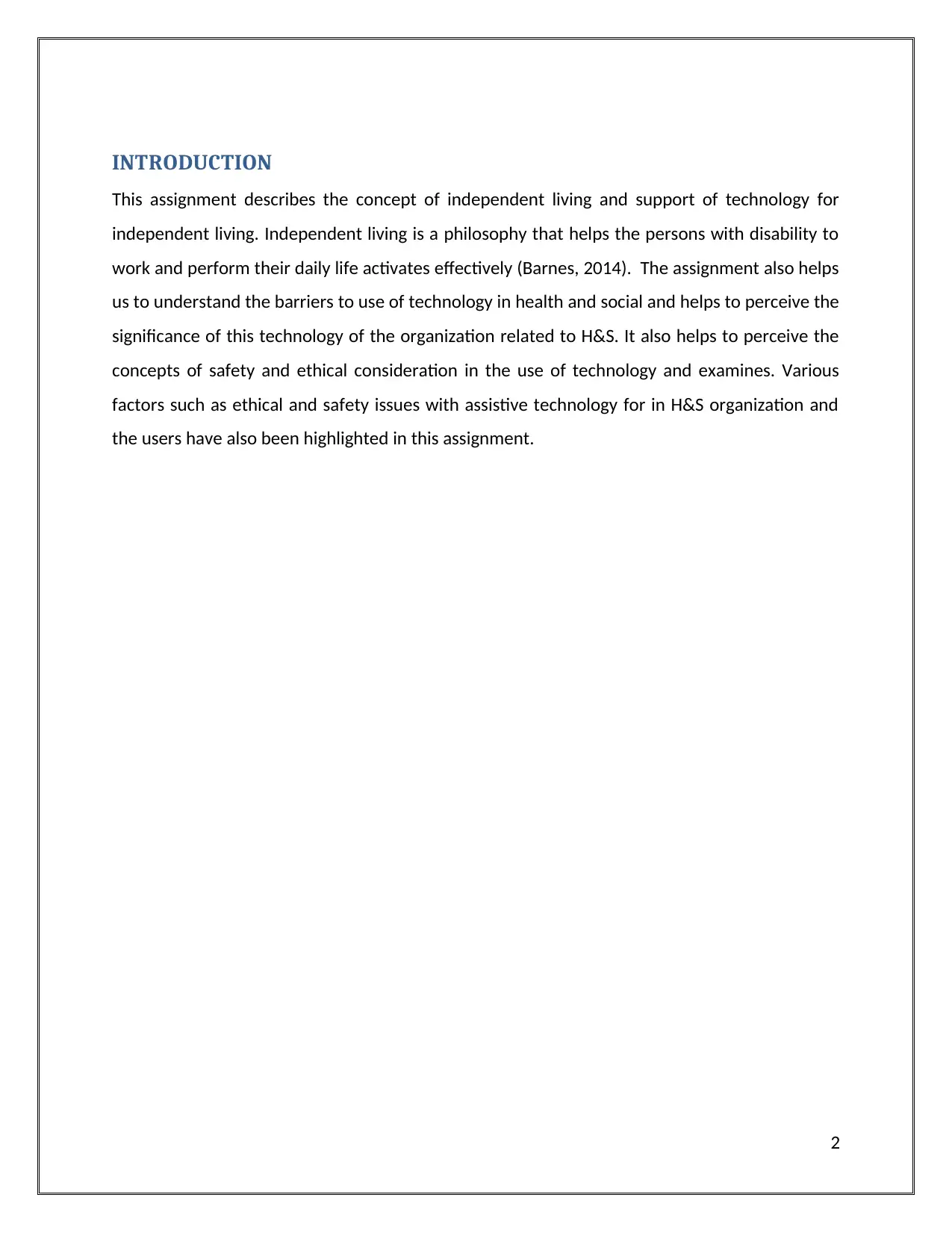
INTRODUCTION
This assignment describes the concept of independent living and support of technology for
independent living. Independent living is a philosophy that helps the persons with disability to
work and perform their daily life activates effectively (Barnes, 2014). The assignment also helps
us to understand the barriers to use of technology in health and social and helps to perceive the
significance of this technology of the organization related to H&S. It also helps to perceive the
concepts of safety and ethical consideration in the use of technology and examines. Various
factors such as ethical and safety issues with assistive technology for in H&S organization and
the users have also been highlighted in this assignment.
2
This assignment describes the concept of independent living and support of technology for
independent living. Independent living is a philosophy that helps the persons with disability to
work and perform their daily life activates effectively (Barnes, 2014). The assignment also helps
us to understand the barriers to use of technology in health and social and helps to perceive the
significance of this technology of the organization related to H&S. It also helps to perceive the
concepts of safety and ethical consideration in the use of technology and examines. Various
factors such as ethical and safety issues with assistive technology for in H&S organization and
the users have also been highlighted in this assignment.
2
⊘ This is a preview!⊘
Do you want full access?
Subscribe today to unlock all pages.

Trusted by 1+ million students worldwide
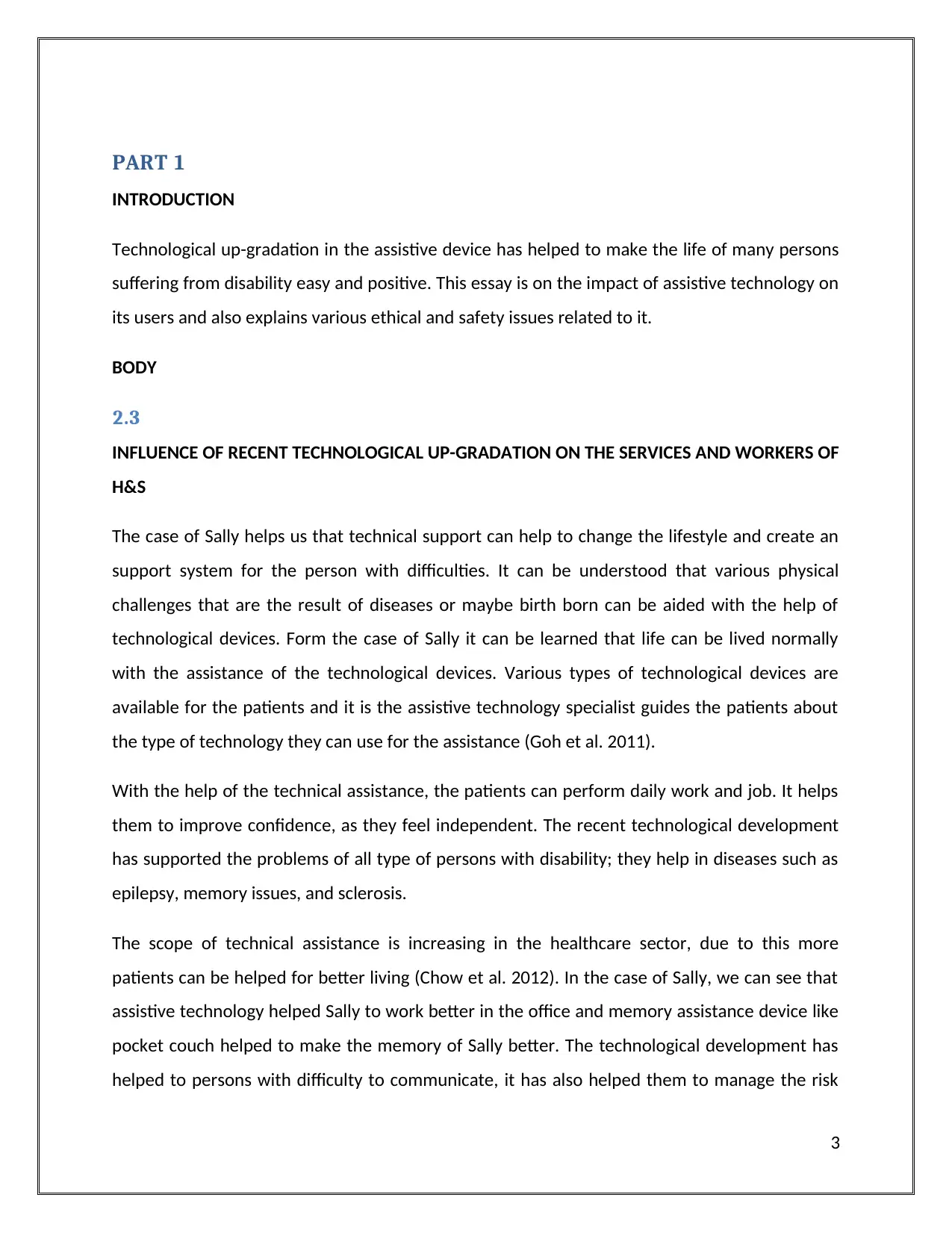
PART 1
INTRODUCTION
Technological up-gradation in the assistive device has helped to make the life of many persons
suffering from disability easy and positive. This essay is on the impact of assistive technology on
its users and also explains various ethical and safety issues related to it.
BODY
2.3
INFLUENCE OF RECENT TECHNOLOGICAL UP-GRADATION ON THE SERVICES AND WORKERS OF
H&S
The case of Sally helps us that technical support can help to change the lifestyle and create an
support system for the person with difficulties. It can be understood that various physical
challenges that are the result of diseases or maybe birth born can be aided with the help of
technological devices. Form the case of Sally it can be learned that life can be lived normally
with the assistance of the technological devices. Various types of technological devices are
available for the patients and it is the assistive technology specialist guides the patients about
the type of technology they can use for the assistance (Goh et al. 2011).
With the help of the technical assistance, the patients can perform daily work and job. It helps
them to improve confidence, as they feel independent. The recent technological development
has supported the problems of all type of persons with disability; they help in diseases such as
epilepsy, memory issues, and sclerosis.
The scope of technical assistance is increasing in the healthcare sector, due to this more
patients can be helped for better living (Chow et al. 2012). In the case of Sally, we can see that
assistive technology helped Sally to work better in the office and memory assistance device like
pocket couch helped to make the memory of Sally better. The technological development has
helped to persons with difficulty to communicate, it has also helped them to manage the risk
3
INTRODUCTION
Technological up-gradation in the assistive device has helped to make the life of many persons
suffering from disability easy and positive. This essay is on the impact of assistive technology on
its users and also explains various ethical and safety issues related to it.
BODY
2.3
INFLUENCE OF RECENT TECHNOLOGICAL UP-GRADATION ON THE SERVICES AND WORKERS OF
H&S
The case of Sally helps us that technical support can help to change the lifestyle and create an
support system for the person with difficulties. It can be understood that various physical
challenges that are the result of diseases or maybe birth born can be aided with the help of
technological devices. Form the case of Sally it can be learned that life can be lived normally
with the assistance of the technological devices. Various types of technological devices are
available for the patients and it is the assistive technology specialist guides the patients about
the type of technology they can use for the assistance (Goh et al. 2011).
With the help of the technical assistance, the patients can perform daily work and job. It helps
them to improve confidence, as they feel independent. The recent technological development
has supported the problems of all type of persons with disability; they help in diseases such as
epilepsy, memory issues, and sclerosis.
The scope of technical assistance is increasing in the healthcare sector, due to this more
patients can be helped for better living (Chow et al. 2012). In the case of Sally, we can see that
assistive technology helped Sally to work better in the office and memory assistance device like
pocket couch helped to make the memory of Sally better. The technological development has
helped to persons with difficulty to communicate, it has also helped them to manage the risk
3
Paraphrase This Document
Need a fresh take? Get an instant paraphrase of this document with our AI Paraphraser

properly as with the help of gadgets such as capacity switches they can call the services
effectively.
4
effectively.
4
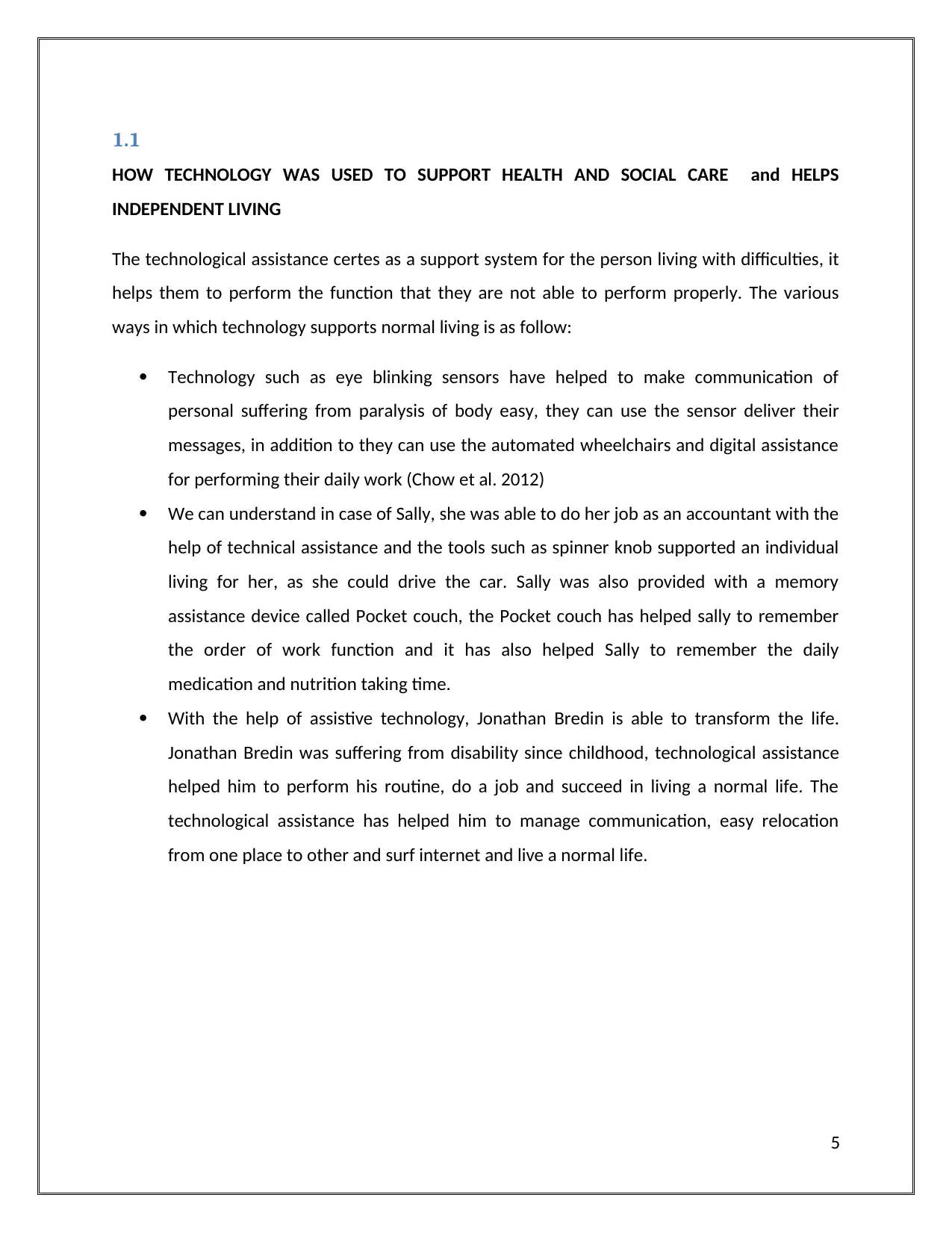
1.1
HOW TECHNOLOGY WAS USED TO SUPPORT HEALTH AND SOCIAL CARE and HELPS
INDEPENDENT LIVING
The technological assistance certes as a support system for the person living with difficulties, it
helps them to perform the function that they are not able to perform properly. The various
ways in which technology supports normal living is as follow:
Technology such as eye blinking sensors have helped to make communication of
personal suffering from paralysis of body easy, they can use the sensor deliver their
messages, in addition to they can use the automated wheelchairs and digital assistance
for performing their daily work (Chow et al. 2012)
We can understand in case of Sally, she was able to do her job as an accountant with the
help of technical assistance and the tools such as spinner knob supported an individual
living for her, as she could drive the car. Sally was also provided with a memory
assistance device called Pocket couch, the Pocket couch has helped sally to remember
the order of work function and it has also helped Sally to remember the daily
medication and nutrition taking time.
With the help of assistive technology, Jonathan Bredin is able to transform the life.
Jonathan Bredin was suffering from disability since childhood, technological assistance
helped him to perform his routine, do a job and succeed in living a normal life. The
technological assistance has helped him to manage communication, easy relocation
from one place to other and surf internet and live a normal life.
5
HOW TECHNOLOGY WAS USED TO SUPPORT HEALTH AND SOCIAL CARE and HELPS
INDEPENDENT LIVING
The technological assistance certes as a support system for the person living with difficulties, it
helps them to perform the function that they are not able to perform properly. The various
ways in which technology supports normal living is as follow:
Technology such as eye blinking sensors have helped to make communication of
personal suffering from paralysis of body easy, they can use the sensor deliver their
messages, in addition to they can use the automated wheelchairs and digital assistance
for performing their daily work (Chow et al. 2012)
We can understand in case of Sally, she was able to do her job as an accountant with the
help of technical assistance and the tools such as spinner knob supported an individual
living for her, as she could drive the car. Sally was also provided with a memory
assistance device called Pocket couch, the Pocket couch has helped sally to remember
the order of work function and it has also helped Sally to remember the daily
medication and nutrition taking time.
With the help of assistive technology, Jonathan Bredin is able to transform the life.
Jonathan Bredin was suffering from disability since childhood, technological assistance
helped him to perform his routine, do a job and succeed in living a normal life. The
technological assistance has helped him to manage communication, easy relocation
from one place to other and surf internet and live a normal life.
5
⊘ This is a preview!⊘
Do you want full access?
Subscribe today to unlock all pages.

Trusted by 1+ million students worldwide
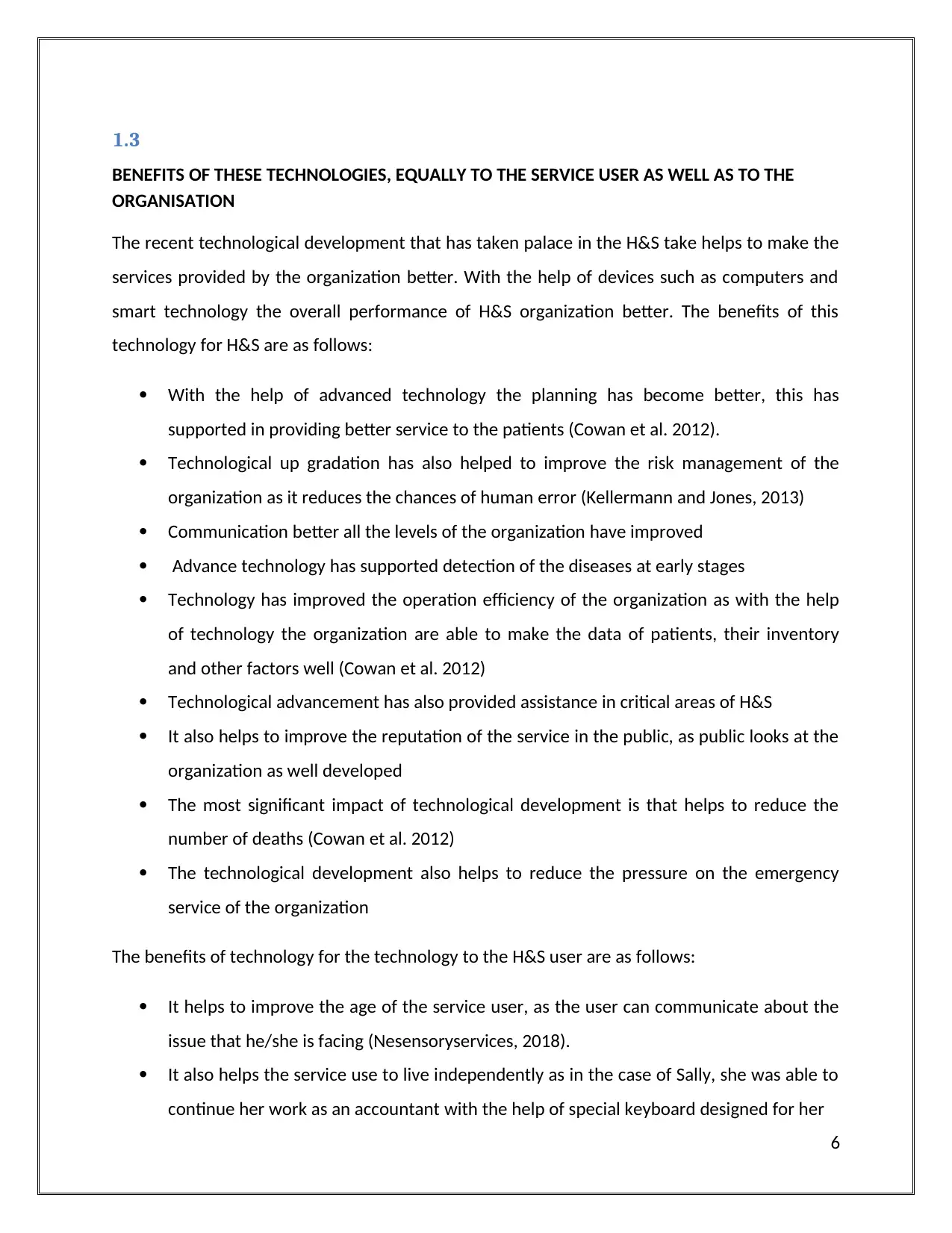
1.3
BENEFITS OF THESE TECHNOLOGIES, EQUALLY TO THE SERVICE USER AS WELL AS TO THE
ORGANISATION
The recent technological development that has taken palace in the H&S take helps to make the
services provided by the organization better. With the help of devices such as computers and
smart technology the overall performance of H&S organization better. The benefits of this
technology for H&S are as follows:
With the help of advanced technology the planning has become better, this has
supported in providing better service to the patients (Cowan et al. 2012).
Technological up gradation has also helped to improve the risk management of the
organization as it reduces the chances of human error (Kellermann and Jones, 2013)
Communication better all the levels of the organization have improved
Advance technology has supported detection of the diseases at early stages
Technology has improved the operation efficiency of the organization as with the help
of technology the organization are able to make the data of patients, their inventory
and other factors well (Cowan et al. 2012)
Technological advancement has also provided assistance in critical areas of H&S
It also helps to improve the reputation of the service in the public, as public looks at the
organization as well developed
The most significant impact of technological development is that helps to reduce the
number of deaths (Cowan et al. 2012)
The technological development also helps to reduce the pressure on the emergency
service of the organization
The benefits of technology for the technology to the H&S user are as follows:
It helps to improve the age of the service user, as the user can communicate about the
issue that he/she is facing (Nesensoryservices, 2018).
It also helps the service use to live independently as in the case of Sally, she was able to
continue her work as an accountant with the help of special keyboard designed for her
6
BENEFITS OF THESE TECHNOLOGIES, EQUALLY TO THE SERVICE USER AS WELL AS TO THE
ORGANISATION
The recent technological development that has taken palace in the H&S take helps to make the
services provided by the organization better. With the help of devices such as computers and
smart technology the overall performance of H&S organization better. The benefits of this
technology for H&S are as follows:
With the help of advanced technology the planning has become better, this has
supported in providing better service to the patients (Cowan et al. 2012).
Technological up gradation has also helped to improve the risk management of the
organization as it reduces the chances of human error (Kellermann and Jones, 2013)
Communication better all the levels of the organization have improved
Advance technology has supported detection of the diseases at early stages
Technology has improved the operation efficiency of the organization as with the help
of technology the organization are able to make the data of patients, their inventory
and other factors well (Cowan et al. 2012)
Technological advancement has also provided assistance in critical areas of H&S
It also helps to improve the reputation of the service in the public, as public looks at the
organization as well developed
The most significant impact of technological development is that helps to reduce the
number of deaths (Cowan et al. 2012)
The technological development also helps to reduce the pressure on the emergency
service of the organization
The benefits of technology for the technology to the H&S user are as follows:
It helps to improve the age of the service user, as the user can communicate about the
issue that he/she is facing (Nesensoryservices, 2018).
It also helps the service use to live independently as in the case of Sally, she was able to
continue her work as an accountant with the help of special keyboard designed for her
6
Paraphrase This Document
Need a fresh take? Get an instant paraphrase of this document with our AI Paraphraser
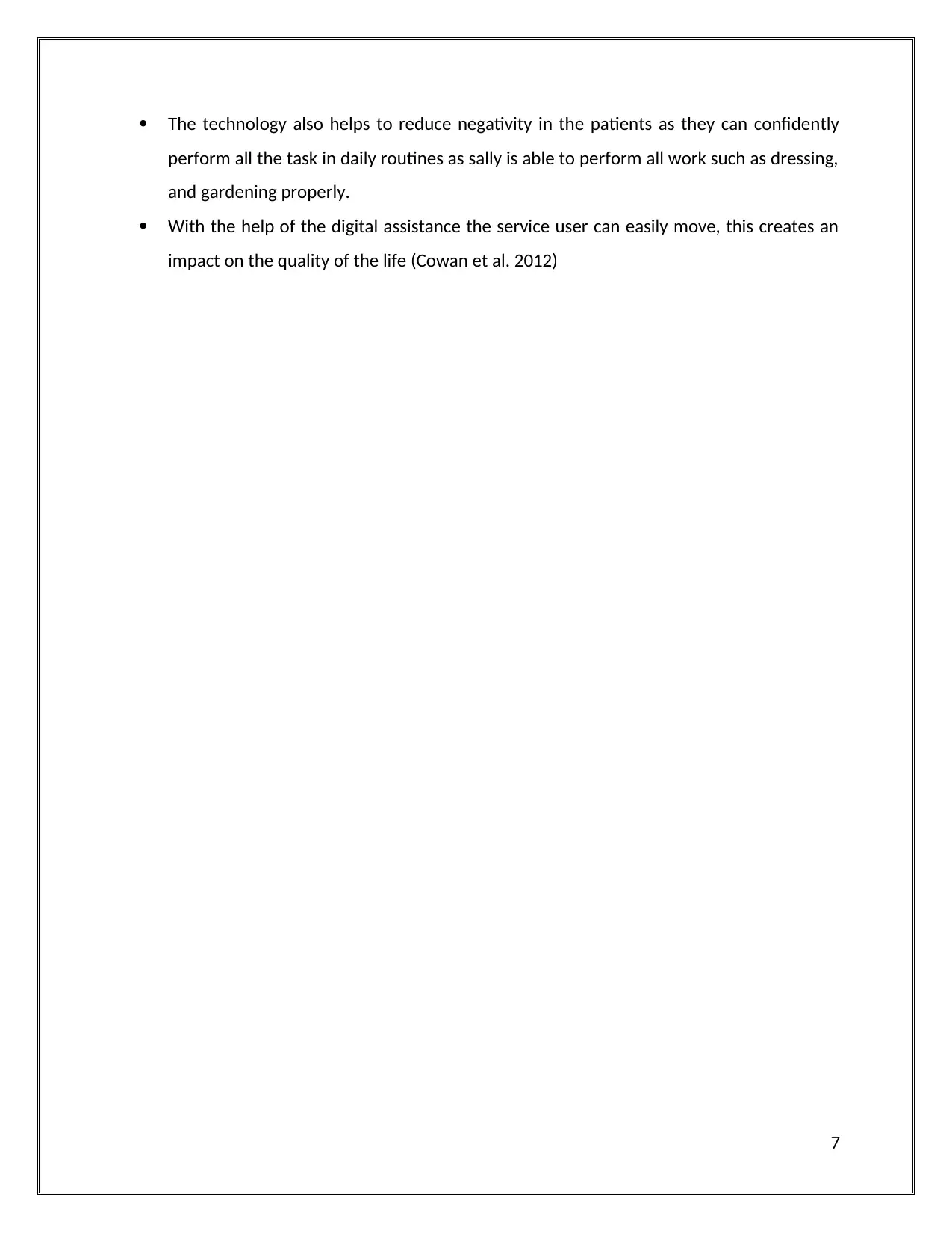
The technology also helps to reduce negativity in the patients as they can confidently
perform all the task in daily routines as sally is able to perform all work such as dressing,
and gardening properly.
With the help of the digital assistance the service user can easily move, this creates an
impact on the quality of the life (Cowan et al. 2012)
7
perform all the task in daily routines as sally is able to perform all work such as dressing,
and gardening properly.
With the help of the digital assistance the service user can easily move, this creates an
impact on the quality of the life (Cowan et al. 2012)
7
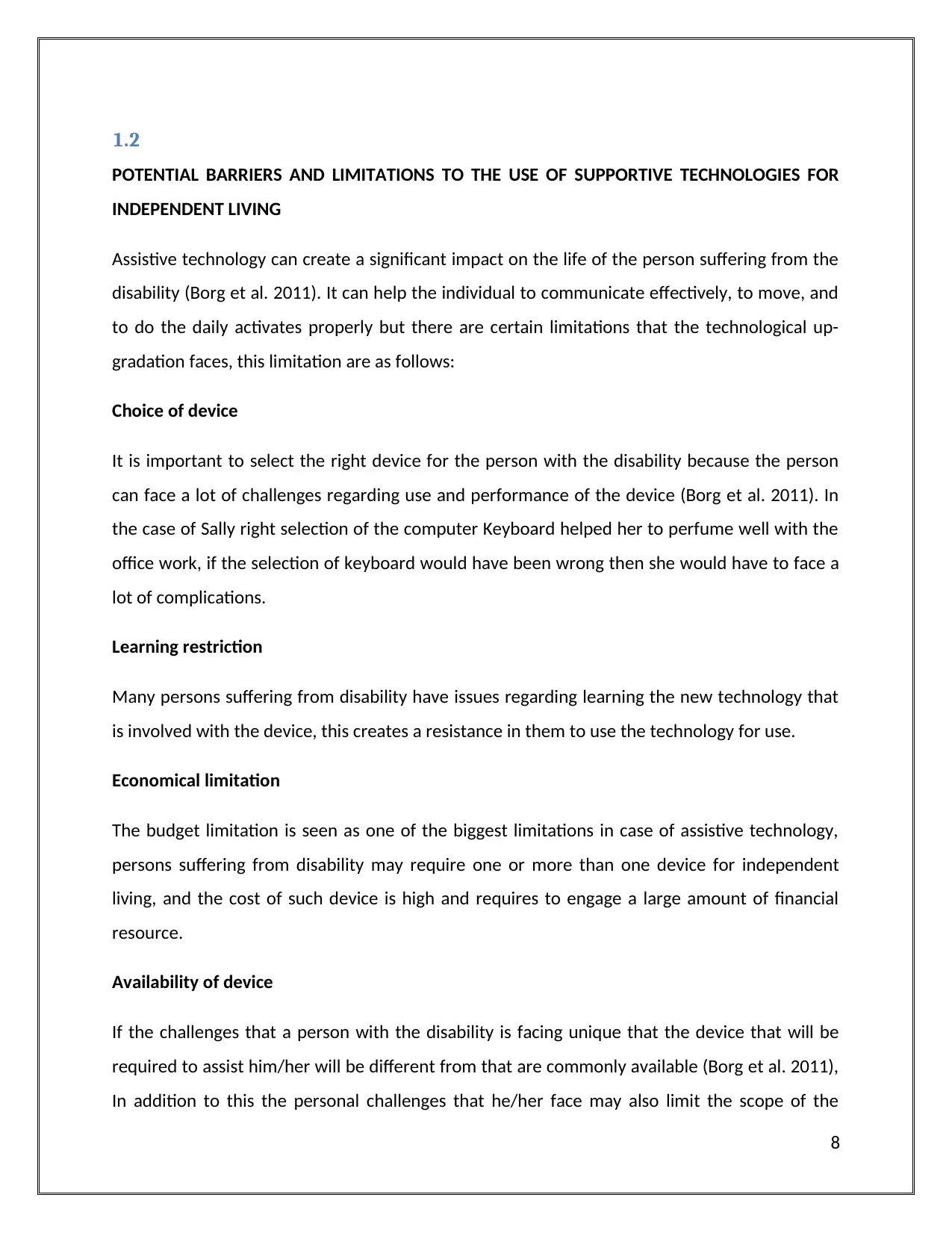
1.2
POTENTIAL BARRIERS AND LIMITATIONS TO THE USE OF SUPPORTIVE TECHNOLOGIES FOR
INDEPENDENT LIVING
Assistive technology can create a significant impact on the life of the person suffering from the
disability (Borg et al. 2011). It can help the individual to communicate effectively, to move, and
to do the daily activates properly but there are certain limitations that the technological up-
gradation faces, this limitation are as follows:
Choice of device
It is important to select the right device for the person with the disability because the person
can face a lot of challenges regarding use and performance of the device (Borg et al. 2011). In
the case of Sally right selection of the computer Keyboard helped her to perfume well with the
office work, if the selection of keyboard would have been wrong then she would have to face a
lot of complications.
Learning restriction
Many persons suffering from disability have issues regarding learning the new technology that
is involved with the device, this creates a resistance in them to use the technology for use.
Economical limitation
The budget limitation is seen as one of the biggest limitations in case of assistive technology,
persons suffering from disability may require one or more than one device for independent
living, and the cost of such device is high and requires to engage a large amount of financial
resource.
Availability of device
If the challenges that a person with the disability is facing unique that the device that will be
required to assist him/her will be different from that are commonly available (Borg et al. 2011),
In addition to this the personal challenges that he/her face may also limit the scope of the
8
POTENTIAL BARRIERS AND LIMITATIONS TO THE USE OF SUPPORTIVE TECHNOLOGIES FOR
INDEPENDENT LIVING
Assistive technology can create a significant impact on the life of the person suffering from the
disability (Borg et al. 2011). It can help the individual to communicate effectively, to move, and
to do the daily activates properly but there are certain limitations that the technological up-
gradation faces, this limitation are as follows:
Choice of device
It is important to select the right device for the person with the disability because the person
can face a lot of challenges regarding use and performance of the device (Borg et al. 2011). In
the case of Sally right selection of the computer Keyboard helped her to perfume well with the
office work, if the selection of keyboard would have been wrong then she would have to face a
lot of complications.
Learning restriction
Many persons suffering from disability have issues regarding learning the new technology that
is involved with the device, this creates a resistance in them to use the technology for use.
Economical limitation
The budget limitation is seen as one of the biggest limitations in case of assistive technology,
persons suffering from disability may require one or more than one device for independent
living, and the cost of such device is high and requires to engage a large amount of financial
resource.
Availability of device
If the challenges that a person with the disability is facing unique that the device that will be
required to assist him/her will be different from that are commonly available (Borg et al. 2011),
In addition to this the personal challenges that he/her face may also limit the scope of the
8
⊘ This is a preview!⊘
Do you want full access?
Subscribe today to unlock all pages.

Trusted by 1+ million students worldwide
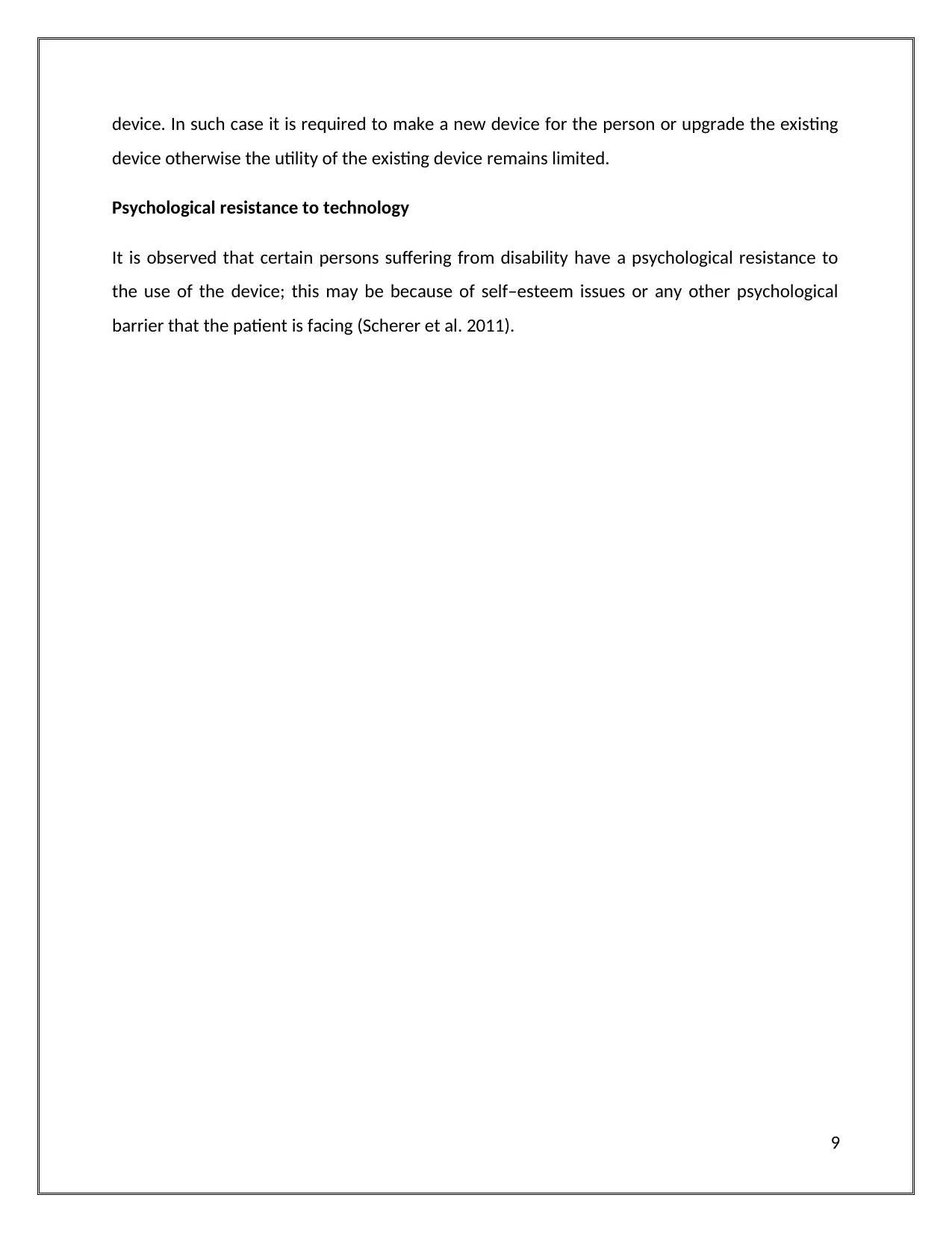
device. In such case it is required to make a new device for the person or upgrade the existing
device otherwise the utility of the existing device remains limited.
Psychological resistance to technology
It is observed that certain persons suffering from disability have a psychological resistance to
the use of the device; this may be because of self–esteem issues or any other psychological
barrier that the patient is facing (Scherer et al. 2011).
9
device otherwise the utility of the existing device remains limited.
Psychological resistance to technology
It is observed that certain persons suffering from disability have a psychological resistance to
the use of the device; this may be because of self–esteem issues or any other psychological
barrier that the patient is facing (Scherer et al. 2011).
9
Paraphrase This Document
Need a fresh take? Get an instant paraphrase of this document with our AI Paraphraser
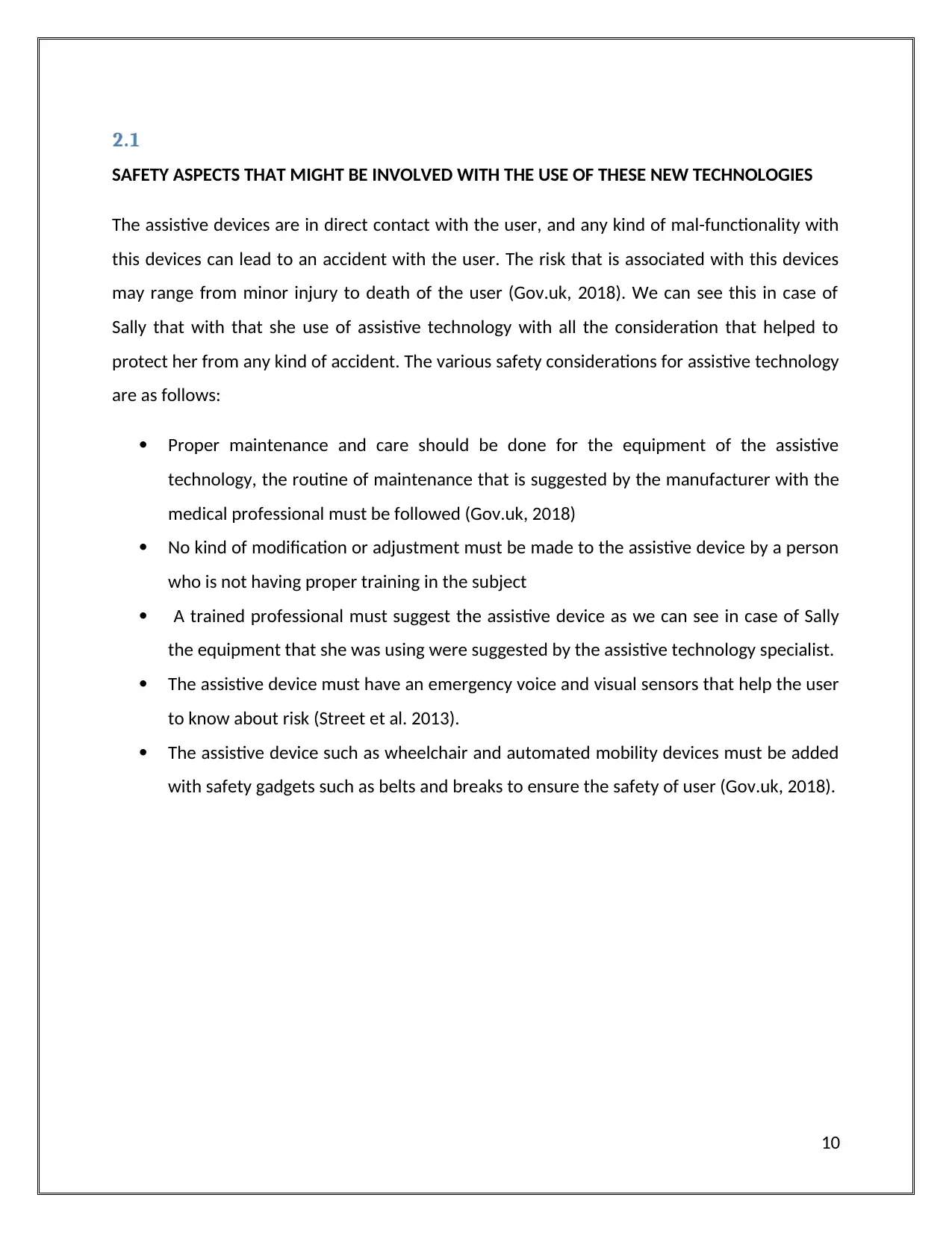
2.1
SAFETY ASPECTS THAT MIGHT BE INVOLVED WITH THE USE OF THESE NEW TECHNOLOGIES
The assistive devices are in direct contact with the user, and any kind of mal-functionality with
this devices can lead to an accident with the user. The risk that is associated with this devices
may range from minor injury to death of the user (Gov.uk, 2018). We can see this in case of
Sally that with that she use of assistive technology with all the consideration that helped to
protect her from any kind of accident. The various safety considerations for assistive technology
are as follows:
Proper maintenance and care should be done for the equipment of the assistive
technology, the routine of maintenance that is suggested by the manufacturer with the
medical professional must be followed (Gov.uk, 2018)
No kind of modification or adjustment must be made to the assistive device by a person
who is not having proper training in the subject
A trained professional must suggest the assistive device as we can see in case of Sally
the equipment that she was using were suggested by the assistive technology specialist.
The assistive device must have an emergency voice and visual sensors that help the user
to know about risk (Street et al. 2013).
The assistive device such as wheelchair and automated mobility devices must be added
with safety gadgets such as belts and breaks to ensure the safety of user (Gov.uk, 2018).
10
SAFETY ASPECTS THAT MIGHT BE INVOLVED WITH THE USE OF THESE NEW TECHNOLOGIES
The assistive devices are in direct contact with the user, and any kind of mal-functionality with
this devices can lead to an accident with the user. The risk that is associated with this devices
may range from minor injury to death of the user (Gov.uk, 2018). We can see this in case of
Sally that with that she use of assistive technology with all the consideration that helped to
protect her from any kind of accident. The various safety considerations for assistive technology
are as follows:
Proper maintenance and care should be done for the equipment of the assistive
technology, the routine of maintenance that is suggested by the manufacturer with the
medical professional must be followed (Gov.uk, 2018)
No kind of modification or adjustment must be made to the assistive device by a person
who is not having proper training in the subject
A trained professional must suggest the assistive device as we can see in case of Sally
the equipment that she was using were suggested by the assistive technology specialist.
The assistive device must have an emergency voice and visual sensors that help the user
to know about risk (Street et al. 2013).
The assistive device such as wheelchair and automated mobility devices must be added
with safety gadgets such as belts and breaks to ensure the safety of user (Gov.uk, 2018).
10
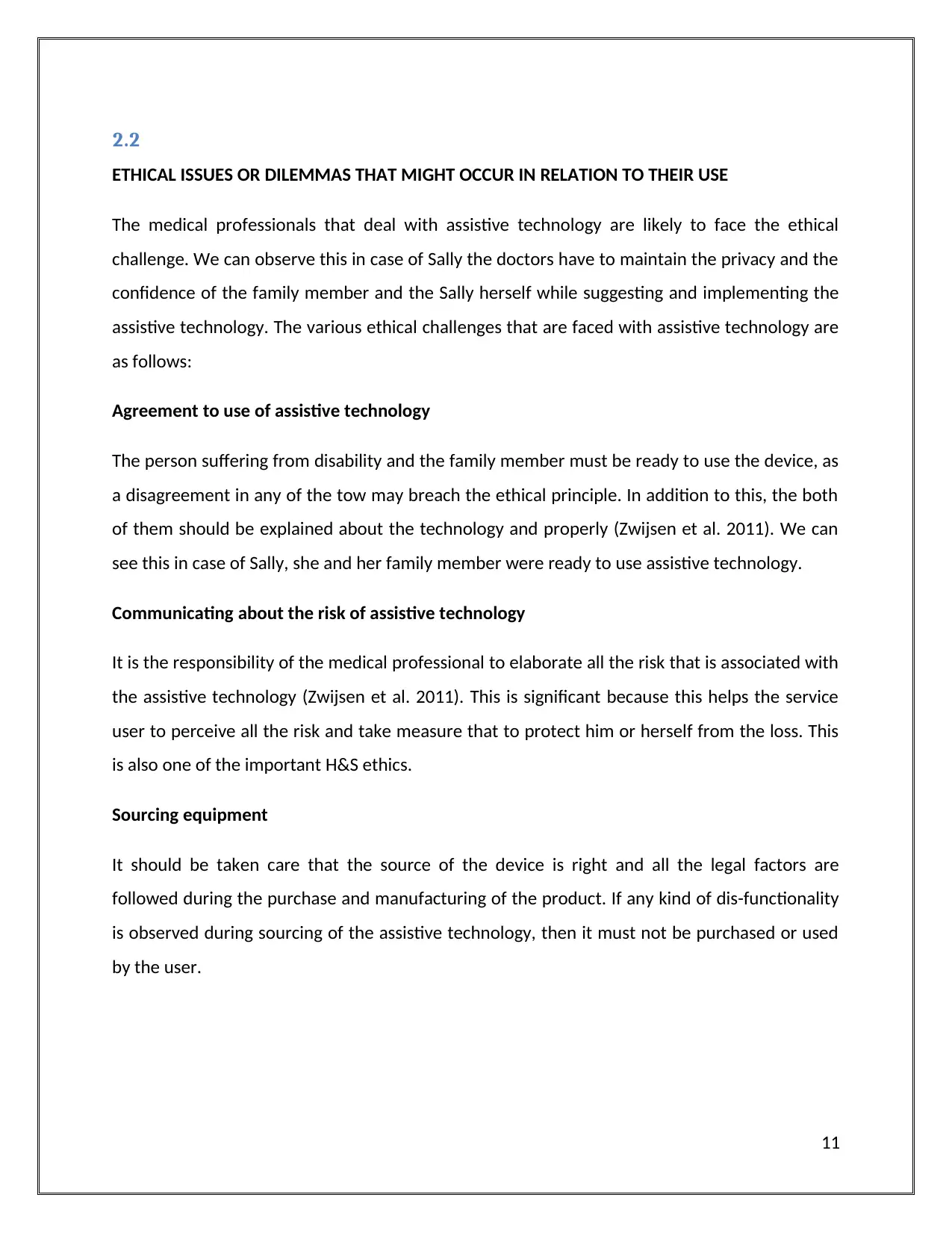
2.2
ETHICAL ISSUES OR DILEMMAS THAT MIGHT OCCUR IN RELATION TO THEIR USE
The medical professionals that deal with assistive technology are likely to face the ethical
challenge. We can observe this in case of Sally the doctors have to maintain the privacy and the
confidence of the family member and the Sally herself while suggesting and implementing the
assistive technology. The various ethical challenges that are faced with assistive technology are
as follows:
Agreement to use of assistive technology
The person suffering from disability and the family member must be ready to use the device, as
a disagreement in any of the tow may breach the ethical principle. In addition to this, the both
of them should be explained about the technology and properly (Zwijsen et al. 2011). We can
see this in case of Sally, she and her family member were ready to use assistive technology.
Communicating about the risk of assistive technology
It is the responsibility of the medical professional to elaborate all the risk that is associated with
the assistive technology (Zwijsen et al. 2011). This is significant because this helps the service
user to perceive all the risk and take measure that to protect him or herself from the loss. This
is also one of the important H&S ethics.
Sourcing equipment
It should be taken care that the source of the device is right and all the legal factors are
followed during the purchase and manufacturing of the product. If any kind of dis-functionality
is observed during sourcing of the assistive technology, then it must not be purchased or used
by the user.
11
ETHICAL ISSUES OR DILEMMAS THAT MIGHT OCCUR IN RELATION TO THEIR USE
The medical professionals that deal with assistive technology are likely to face the ethical
challenge. We can observe this in case of Sally the doctors have to maintain the privacy and the
confidence of the family member and the Sally herself while suggesting and implementing the
assistive technology. The various ethical challenges that are faced with assistive technology are
as follows:
Agreement to use of assistive technology
The person suffering from disability and the family member must be ready to use the device, as
a disagreement in any of the tow may breach the ethical principle. In addition to this, the both
of them should be explained about the technology and properly (Zwijsen et al. 2011). We can
see this in case of Sally, she and her family member were ready to use assistive technology.
Communicating about the risk of assistive technology
It is the responsibility of the medical professional to elaborate all the risk that is associated with
the assistive technology (Zwijsen et al. 2011). This is significant because this helps the service
user to perceive all the risk and take measure that to protect him or herself from the loss. This
is also one of the important H&S ethics.
Sourcing equipment
It should be taken care that the source of the device is right and all the legal factors are
followed during the purchase and manufacturing of the product. If any kind of dis-functionality
is observed during sourcing of the assistive technology, then it must not be purchased or used
by the user.
11
⊘ This is a preview!⊘
Do you want full access?
Subscribe today to unlock all pages.

Trusted by 1+ million students worldwide
1 out of 20
Related Documents
Your All-in-One AI-Powered Toolkit for Academic Success.
+13062052269
info@desklib.com
Available 24*7 on WhatsApp / Email
![[object Object]](/_next/static/media/star-bottom.7253800d.svg)
Unlock your academic potential
Copyright © 2020–2025 A2Z Services. All Rights Reserved. Developed and managed by ZUCOL.





